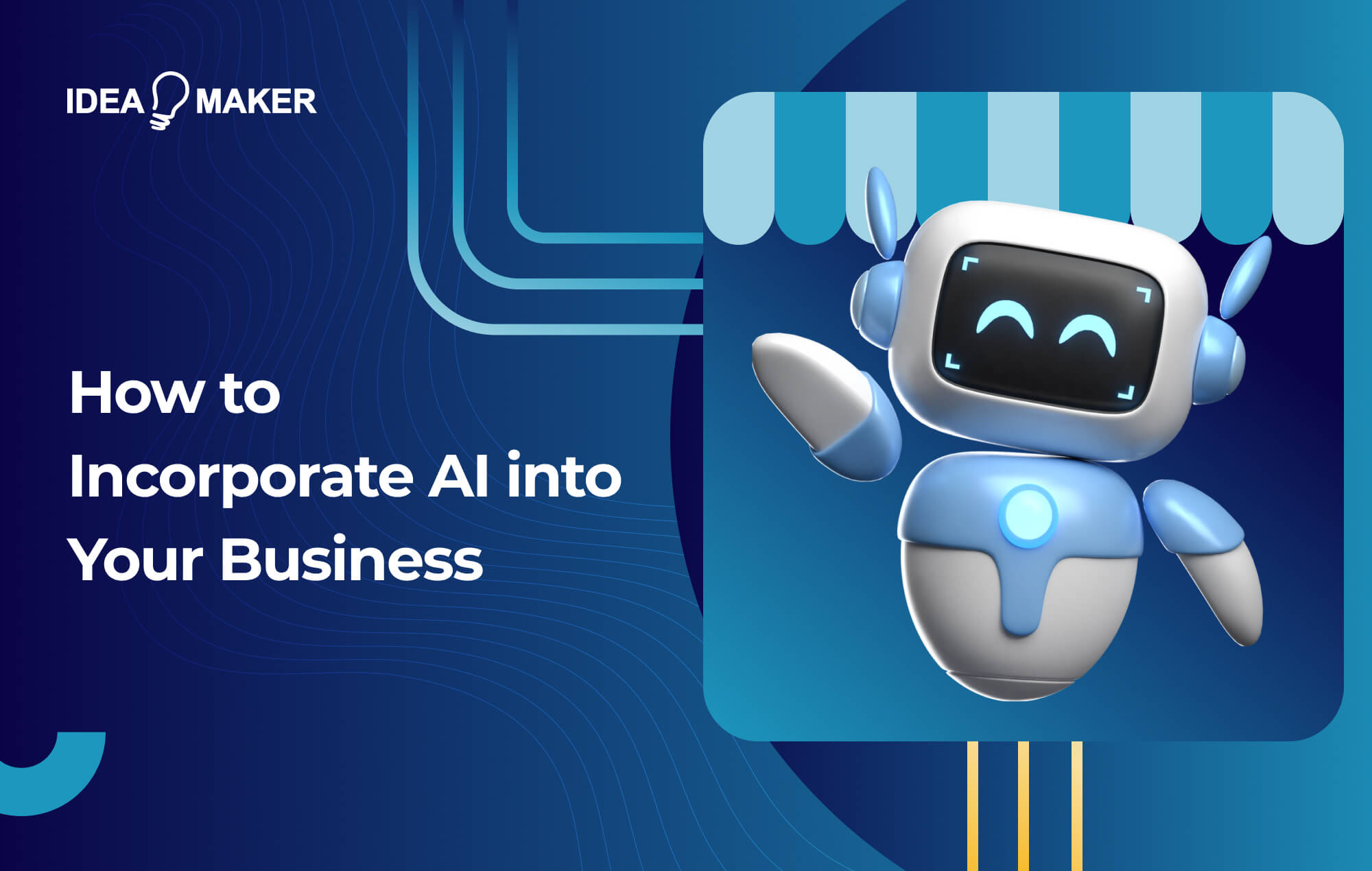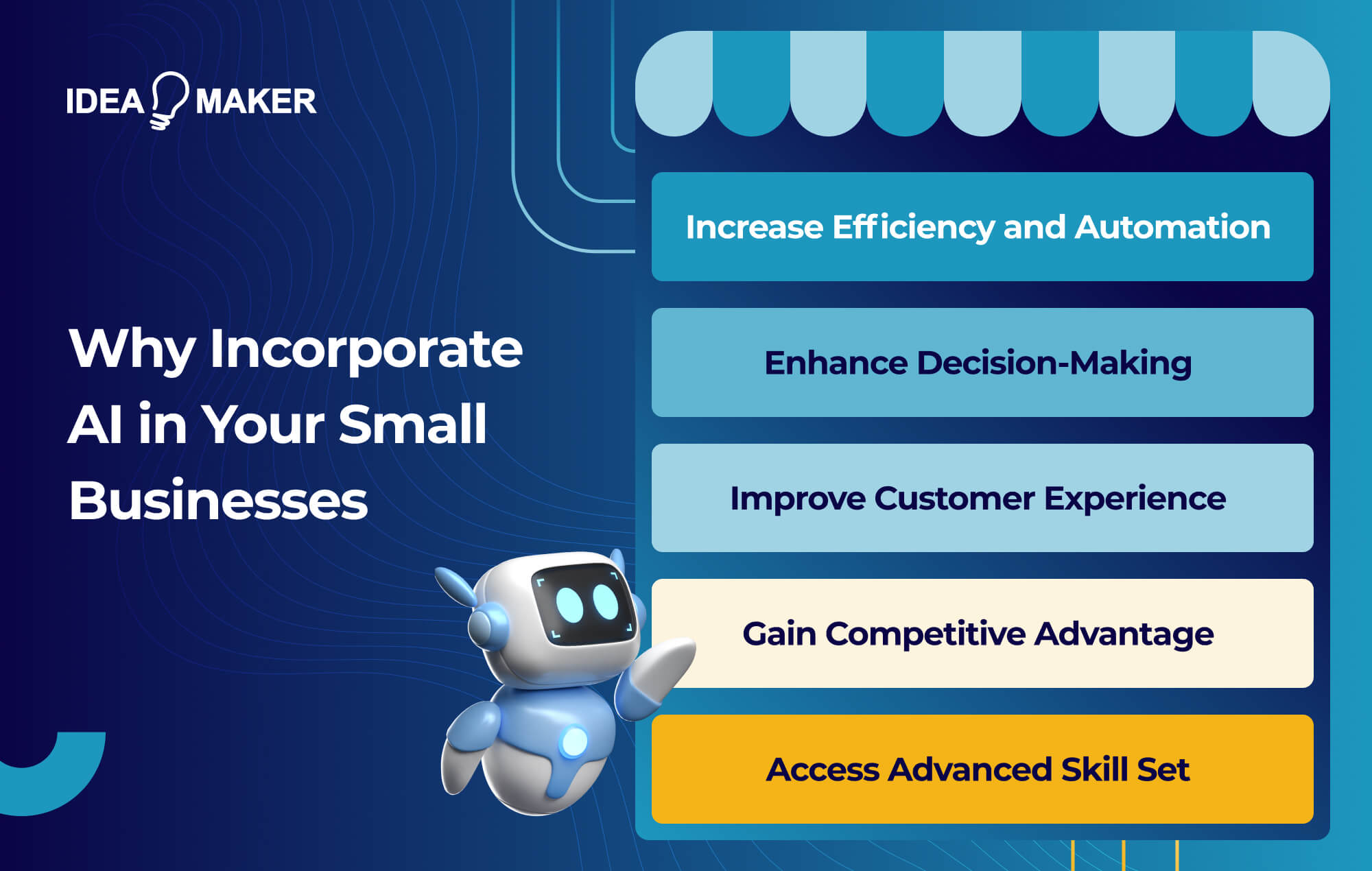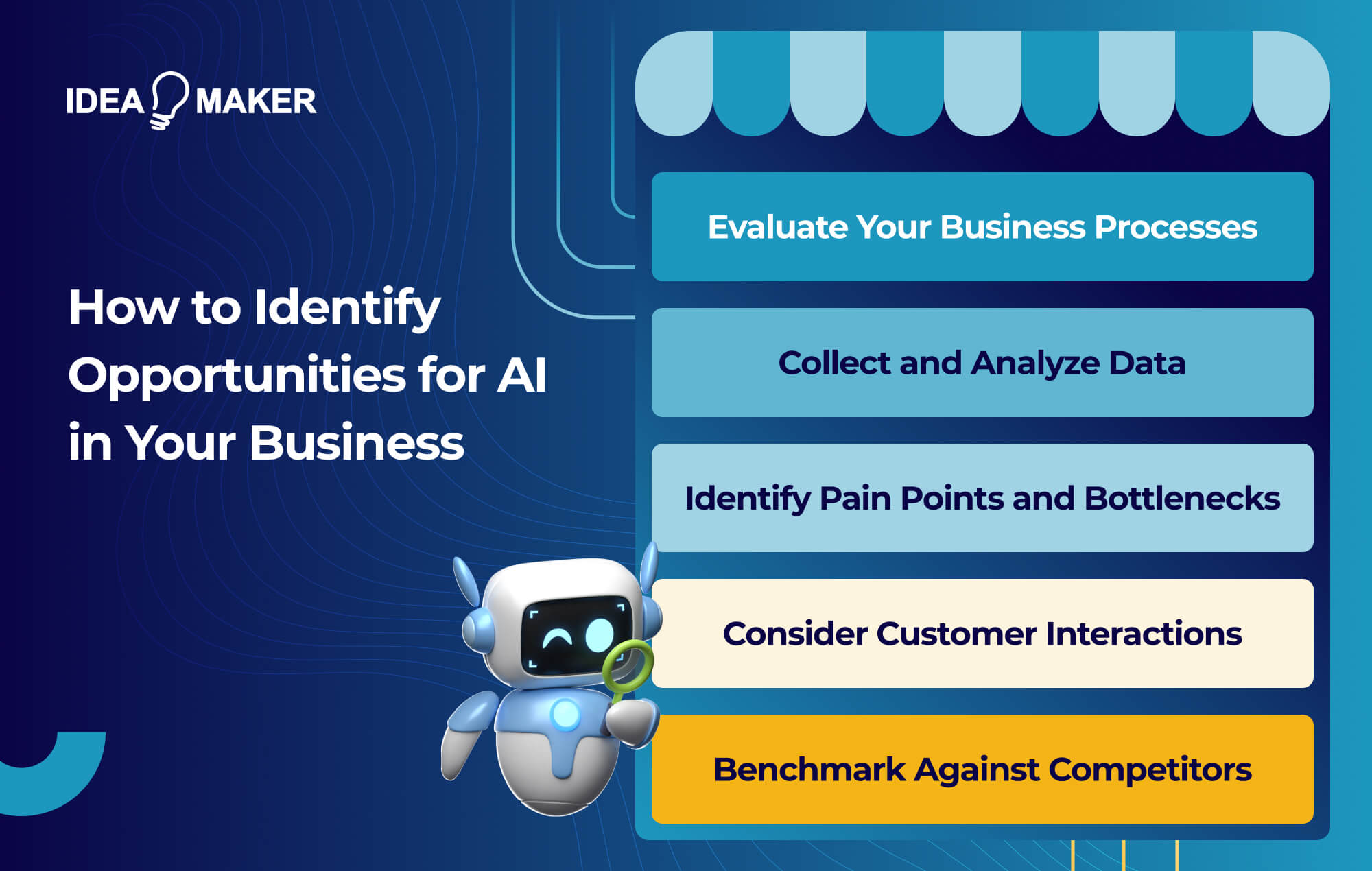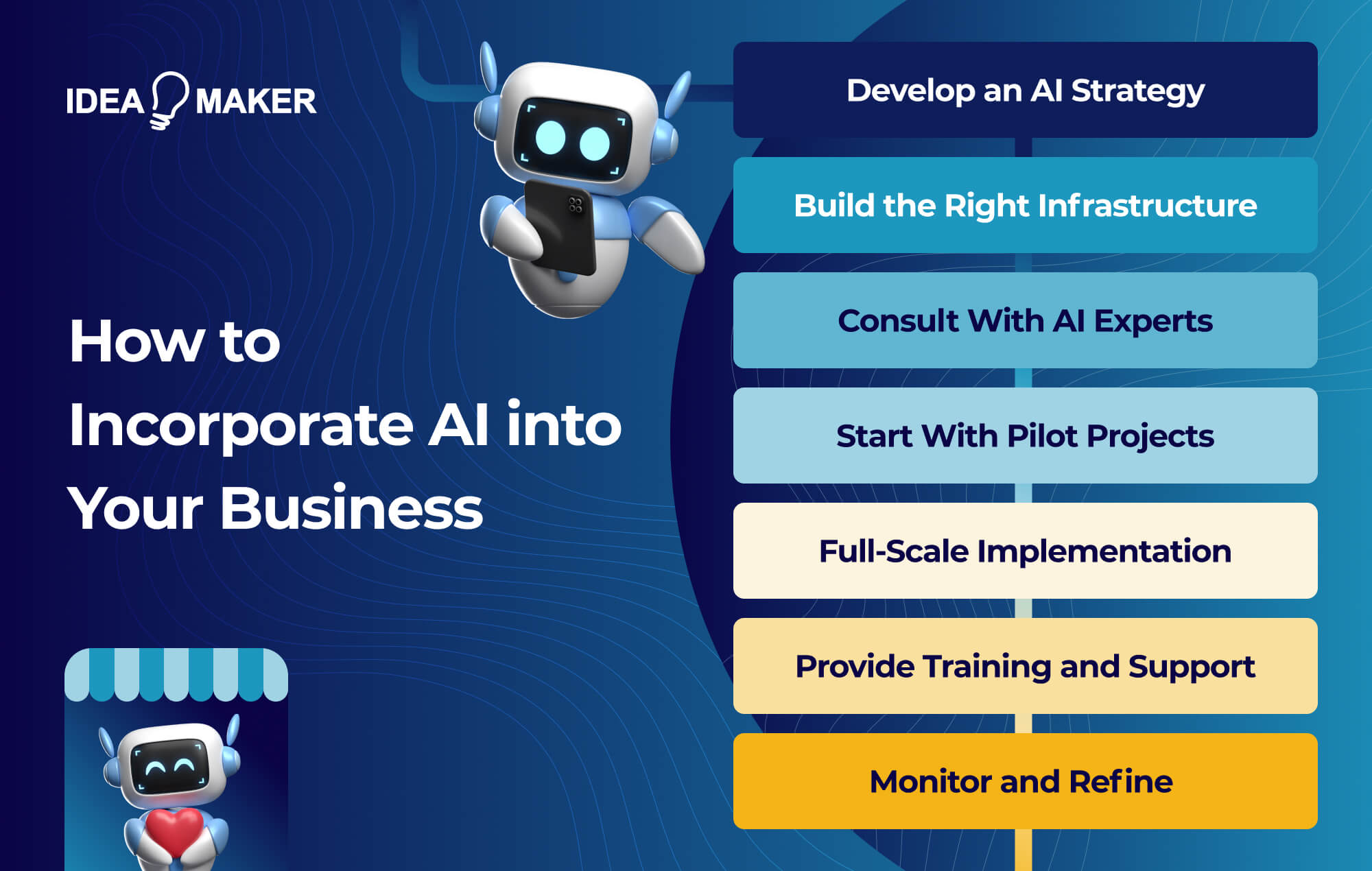Table of Contents
Artificial intelligence (AI) technologies are transforming businesses across all industries. As AI capabilities continue to advance, companies of all sizes are exploring ways to leverage these innovations to optimize operations and outpace competitors. For small businesses, in particular, AI business integration presents a valuable opportunity to level the playing field.
Knowing exactly which areas of AI to invest in, and how to incorporate AI into your business to enhance efficiency, decision-making, customer service, and competitive advantage can be complex. However, there are some very simple practical steps and benefits to implementing AI software in business that you can access with minimal specialist knowledge such as the use of custom chatbots to enhance and elevate your customer service provision.
This article will explore the practical steps small business owners can take to incorporate AI into their existing processes and infrastructure.
Why Incorporate AI in Your Small Businesses
There are compelling reasons for small businesses to consider implementing operational AI business integration . Recent polls and economic analyses reveal the positive impact AI can have. The 2023 BPC and Morning Consult poll found that 83% of small business owners utilizing AI say it has improved systems, boosted efficiency, freed up time, and assisted with content production.
Moreover, 33% of small business owners identify as early adopters of new technologies, and 58% intend to invest in AI solutions over the next year. The U.S. Chamber of Commerce’s nationwide survey examining AI’s effect uncovered a correlation between higher AI usage and increased sales, employment, and profits among small businesses. Of the companies surveyed, 23% currently use AI, and those adopters saw a 12-point higher likelihood of profit growth compared to their non-AI-using counterparts.
Increase Efficiency and Automation
One of AI’s most impactful benefits for small businesses is enhanced efficiency through the automation of repetitive tasks. By implementing AI solutions to handle time-consuming administrative duties, data entry, communications, and more, staff hours can be allocated to more strategic priorities.
Specific efficiency gains may include:
- Streamline repetitive tasks like data input, reporting, scheduling, and follow-ups using AI-powered tools.
- Optimize resource and labor allocation based on AI analysis of workloads and prediction of upcoming needs.
Enhance Decision-Making
In addition to efficiency gains, AI technologies can bolster small business decision-making using data-driven insights. By processing volumes of information faster than humans, AI can uncover patterns, trends, and metrics to inform strategy.
Key AI capabilities for improving decisions include:
- Leverage data-driven insights from AI to identify issues, opportunities, and benchmark performance.
- Predict trends and likely outcomes to support planning for scenario analysis.
- Access digestible reports and dashboards powered by AI algorithms.
Improve Customer Experience
There are many ways that AI can improve customer experience. Delivering excellent customer experiences is critical for all businesses, but small companies can have an edge over large corporations regarding personalization. Integrating AI solutions for customer service and interactions allows small businesses to leverage automation while providing individualized attention that builds loyalty.
Specific applications include:
- Personalize interactions by using AI to gather, analyze, and apply customer data.
- Provide 24/7 support through conversational chatbots customized to understand unique language and requests.
Gain Competitive Advantage
Incorporating AI not only improves internal operations but also serves as a differentiator from competitors without robust tech capabilities. For small businesses, being an early AI adopter can bring significant advantages.
Ways AI delivers a competitive edge:
- Adopt innovative technologies ahead of rivals to attract tech-savvy customers.
- Differentiate service and product offerings through customized applications of AI.
- Outpace competitors who lack insight and efficiency gains from AI.
Access Advanced Skill Set
Often, small businesses simply don’t have the resources or bandwidth to hire data scientists, predictive modelers, conversation design specialists, and other high-level tech talent. AI solutions allow small companies to benefit from advanced capabilities without needing entire analytics or IT departments.
The key advantages of leveraging AI skill sets:
- Benefit from AI’s capabilities without hiring multiple specialists.
- Eliminate the need for statistical analysis, data modeling, and other expert skills training for staff.
- Focus top talent on core business functions rather than supporting tech.
Between AI-as-a-service platforms and consultative partnerships, small businesses can tap into a world-class skill set. Instead of competing for top tech talent, companies can deploy ready-made AI tools enhanced by outside experts. This allows small leadership teams to concentrate on what they do best while AI handles complex optimizations in the background.
How to Identify Opportunities for AI in Your Business
When determining where and how to incorporate AI in a small business, a key first step is systematically evaluating current processes and workflows. By mapping out existing ways of working and completing tasks, you can pinpoint areas that could benefit from automation or optimization.
Evaluate Your Business Processes
The first step towards identifying where and how to incorporate AI in your small business is to thoroughly evaluate your existing business processes and workflows. This involves mapping out your current systems, tasks, and procedures to holistically understand how your business operates.
Then, you should document the step-by-step process for your core business functions such as sales, marketing, customer service, HR, accounting, manufacturing, or production workflows. Additionally, identify your key stakeholders, data, and tools utilized in each process. This will enable you to pinpoint repetitive tasks that can be automated, including bottlenecks where efficiency improvements are needed.
Next, analyze the time and resources allocated for various processes. Are there any workflows that consume a disproportionate amount of employee time and effort? For example, manually entering data or copying information across multiple systems. These are prime targets for AI automation. Your evaluation sets the foundation for transforming operations with artificial intelligence.
Collect and Analyze Data
Your business process evaluation data provides tremendous insights into pain points and bottlenecks. However, to implement AI solutions effectively, you need high-quality, relevant, and accessible data from all key sources.
Gather data from across departments–sales, marketing, operations, and finance. Bring together information from your client relationship management, inventory management systems, point of sale devices, website, social media channels and other sources. You can then leverage data mining techniques to extract and compile your data into a single repository.
Next, analyze this data set to uncover usage trends, customer behavior patterns, and operational performance metrics. Identify correlations between marketing campaigns and sales growth or seasonal factors influencing inventory demands. Analytics will provide clarity on your focus areas for AI implementation.
Identify Pain Points and Bottlenecks
With deeper analysis of your data, start mapping the pain points and bottlenecks hindering efficiency in your workflows. Pinpoint areas where repetitive manual tasks lead to delays or errors, such as data entry between systems or invoice processing. Identify instances where information gaps lead to ineffective decision-making due to lack of insights.
Prioritize these issues based on the potential impact AI solutions can have on enhancing productivity, performance, or decision-making, and the feasibility of implementation. The goal is to target high-value yet reasonably achievable use cases for your initial AI projects to demonstrate returns on investments.
For instance, automating data capture through AI-based data entry or applying machine learning to detect patterns in support calls and recommend solutions to agents. Quick wins build buy-in across the organization to adopt AI.
Consider Customer Interactions
Customer interactions and experiences present a valuable source of data and insights into potential AI applications. Analyze customer support tickets, call transcripts, chat logs, email history, and social media conversations to detect common complaints, requests, and queries. Identify frequent problem areas that can be addressed through an AI chatbot providing 24/7 automated customer service.
Examine your client relationship management data, website analytics, and marketing campaign metrics to study customer engagement patterns across sales and marketing channels over time. Develop AI-powered lead scoring models to identify and target high-intent customers.
Feedback surveys also provide direct input into customers’ needs and preferences. Apply sentiment analysis to open-ended survey responses to surface key considerations for new products and service enhancements powered by AI.
Benchmark Against Competitors
Research how competitors in your industry are leveraging AI across business functions – from predictive inventory planning to personalized promotions.
Identify potential gaps in your capabilities for integrating AI-based automation, insights, and engagement. For example, competitors may have more advanced predictive analytics or intelligent process automation.
Also, consider emerging AI applications relevant to your customers and industry. Conversational interfaces like chatbots and voice assistants are now considered the minimum requirement. Explore cutting-edge use cases such as AI-generated content, hyper personalization, and intelligent process mining.
Benchmarking allows you to recognize the gap between what your existing customers have already bought from you and what other products and services you can offer them. This may include opportunities to differentiate your business from peers by applying AI innovations. It also informs your technology roadmap for rolling out AI tools aligned to short and long-term strategic priorities.
Now that you have laid the groundwork, you and your team are ready to begin implementing AI in your small business.
How to Incorporate AI into Your Business
With the groundwork for identifying high-potential AI use cases laid out, the next phase is execution–developing an implementation roadmap and putting team members in place that can support your implementation team.
Develop an AI Strategy
Define the vision, objectives, scope, and roadmap for activating AI solutions in your organization. Having clear goals and success metrics tailored to business priorities and outcomes provides direction and facilitates stakeholder alignment.
For example, the goal may be to reduce customer support costs by 20% in 12 months by deploying an AI chatbot. Or improve lead conversion rates by 10% in 6 months using predictive lead scoring.
Based on the use cases identified, detail the necessary AI technical capabilities and tools required. Then, allocate a budget for potential software purchases, data infrastructure investments, external AI talent, or consultancies to support development and deployment.
Build the Right Infrastructure
High-quality, organized, and accessible data is the foundation for fueling AI algorithms. Invest in data warehousing, ETL pipelines, and governance protocols to ensure reliable data for model development. Assess existing IT infrastructure–server capacity, network bandwidth, and storage availability–and upgrade capabilities to support AI model building, deployment, and inferencing. Cloud platforms offer flexible and scalable options.
Finally, identify and procure the right software tools–whether proprietary AI platforms from vendors or open-source libraries–tailored to your use case requirements for aspects like NLP, computer vision, and process automation. With the strategy, budget allocation, and infrastructure in place, your small business will be poised to develop, launch, and scale AI solutions effectively.
Consult With AI Experts
While you may understand where and how AI can drive value, specialized skills are essential for actual development and deployment. Partnering with experienced AI talent or services accelerates progress.
Consult AI experts to assess use cases, select optimal tools and algorithms, architect the best technical approach, and provide guidance on scaling implementation. They offer a strategic perspective on translating business priorities into AI solutions.
Alternatively, off the shelf, AI-as-a-service platforms enable you to leverage pre-built models and tools for common applications like chatbots, predictive analytics, and computer vision with minimal in-house development. These can help accelerate time-to-value.
Start With Pilot Projects
Commence by piloting AI solutions in a controlled, low-risk environment to test capabilities and build internal capability. For example, first, deploy a customer service chatbot to a small segment of users to gather feedback. Or develop a predictive model on a sampled dataset and measure accuracy before applying it business-wide.
Your pilot group provides a contained environment to continuously monitor the performance of the AI applications and fine-tune the technology based on observations and user input. Successful small-scale tests demonstrate the returns on investment potential to stakeholders, allowing you to make the case for larger investment and scale-up implementation across the organization. This agile, iterative approach helps manage risk and maximize learning.
Full-Scale Implementation
Once AI applications have promising results during the pilot phase, they build the case for full production rollout across relevant business units or functions. Expand access to the AI solutions, whether chatbots, predictive models, or process automation, to your wider employee base or customer channels. This requires scaling up the underlying infrastructure to handle increased data volumes and usage traffic.
You will need to provide comprehensive training and support to smooth the transition for stakeholders impacted by the AI capabilities now available at their fingertips. Ensure you clearly communicate timelines, rollout plans, and expected outcomes to your team members.
Develop protocols for continuous monitoring and updates to your AI models at an enterprise-grade level. As data accumulates, periodically retrain your models to ensure relevance and accuracy. At a larger scale, some unintended biases or inaccuracies in model performance may surface that require review and rectification. Maintain rigorous governance standards around the use of AI.
Full implementation signals the transition of AI solutions from controlled experimentation to standardized business applications. Realizing the fully envisaged return on investment depends on seamless integration into workflows across functions, which requires executive mandate and operational excellence.
With proven value delivered through pilots and strong foundational capabilities in place, small businesses can confidently unlock AI’s potential.
Provide Training and Support
User adoption is key to realizing the full potential of AI solutions. Employees across your organization must understand how to utilize AI tools and integrate outputs into their workflows for maximum business impact.
Educate staff on the capabilities of new AI applications through workshops and documentation. Make training modules available for self-service learning. Share best practices for leveraging AI-driven insights or automation within their roles.
Appoint internal AI champions as go-to resources to support teams in getting started and resolving any issues they encounter during operation. Technical support teams will also need to develop expertise in maintaining AI systems.
Monitor and Refine
Track the performance of AI applications against defined metrics following deployment. Maintain rigor of continuous monitoring to flag any deviations or drops in model accuracy through automated testing and observability pipelines.
Diagnose the factors responsible for underperformance–whether data issues, external environment changes, or the need to periodically retrain models on new data. Then, undertake focused initiatives to retrain models or optimize algorithms accordingly.
Solicit ongoing user feedback and measure satisfaction levels to identify areas for enhancement in your AI tools. Based on insights, expand the breadth and depth of AI capabilities over time. The ability to continuously monitor, diagnose, and refine issues is imperative for AI solutions to consistently deliver maximum value. Commit resources for ongoing maintenance and progress.
Consult Idea Maker to Help You Incorporate AI inYour Small Business
While identifying the right use cases and implementation methodology are crucial first steps, realizing AI’s full potential requires specialized expertise. Ideamaker offers end-to-end AI consulting services to guide small businesses through building impactful AI solutions tailored to their unique needs.
With extensive experience implementing AI across industries and functions, Ideamaker consultants employ proven frameworks to drive adoption. We also provide advice on data, infrastructure, and capability prerequisites to prepare clients for success.
As an AI solutions partner, Ideamaker alleviates the burden of enterprises needing to build internal AI competencies. Our experts manage the technical complexities, enabling clients to focus on their core business priorities.
Take the first step towards transforming your small business with AI. Reach out to the Idea Maker team today to learn more.
















